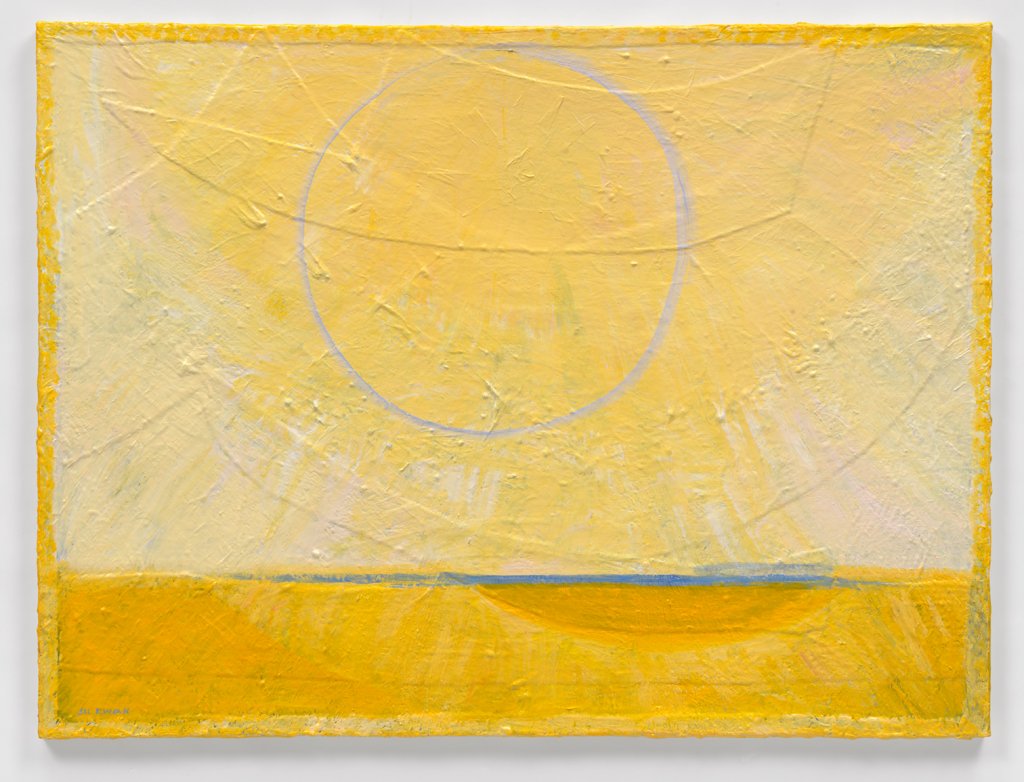Cover Art Commentary: Gregg Hertzlieb on Su Kwak

Su Kwak (b. 1949)
Cosmic Light #40, 2015
Acrylic on canvas, 30 x 40 inches
Collection of the Artist
The Brauer Museum of Art recently held a well-received exhibition of the Cosmic Light Series of paintings in which Korean American artist Su Kwak presented the fruits of her ongoing exploration of inspirational abstraction. For most of her career, Kwak has used materials and pictorial surfaces as metaphors for bodily and spiritual states, with pigment and gesture not only adorning the canvases but also paradoxically healing them from the exertions wrought by their making. Cosmic Light #40 is typical in this regard but in its relative monochrome glows in a kind of self-containment, an object unto itself without the more intentional references to deep space or swirling galaxies found in other pieces in the show. Here the emphasis is on the light that becomes cosmic, and less the light found in the Cosmos.
As a deeply faithful person and a nurse at one time in her life, Kwak is motivated by a desire to help heal the wounds and struggles of those around her. She recognizes the literal and figurative truth of light having therapeutic qualities, and for her the greatest light was one that transformed the universe, the light arising from a transcendent sacrifice borne out of love. Kwak sees Jesus’s crucifixion as an event moving beyond the particulars of earthly circumstances or events and into a kind of rift that can only be captured or expressed pictorially through abstract, even nonobjective means. Kwak’s spacescapes show a beyond where divine sacrifice leads, but the impossibility of capturing such depths is acknowledged by the artist in her collaging on the paintings’ surfaces actual Korean Bible pages. For the artist, Jesus’s death on the cross opened a portal into a dimension of light or love only attainable through paint, and yet accessibility is only gained through a frank and direct experience of the object before the viewer, covered as it is with pigment and pages. The spirit only makes sense in light of the flesh.
Kwak treats the surface not by directly applying an image, but by building a history, a topography. Humans never seem to be clean slates, so applied sheets or fragments of canvases activate the painting surface; the white rectangle receives its individuality, with universality reached through empathy for the object, the entity, the body before the viewer. Onto this expressive object that wears and reflects its history, Kwak spreads layers of liquid light, especially clear in its reference in this case because of the main or dominant yellow color. The light defines, as light does in life and the world, but in this case it also encases or preserves. Everything is to some degree made by or defined by light, and Kwak’s painting does so in simultaneously symbolic and material ways. Her yellow has no terrestrial referent but is simply a color that in its literal plasticity gives physical existence to a witness, a prayer. Just as human identity can hardly be captured by a list or description of physical ingredients, Kwak’s paintings combine acrylic, canvas, and wood stretchers into a testimony to a wresting with a reality beyond the immediate. That which is familiar is unfamiliar, so that the magnitude of love and selflessness can be felt through the direction of earthly means toward a focused or intent goal, stylized in its configuration to speak to a divine nature.
Above scars, above history, above layers of paint and applied canvas that weigh on the picture plane like years of endurance and survival, a lavender circle hovers, the thinness of the circle reading like a delicate application of order atop the turbulence of time and time’s inevitable effects on the body. The swoop of collaged canvas seems to direct the gaze of the circle downward to a shadow on the ochre ground. Under the yellow light is the rose of reflection, and then reflection shines on the shadow. Kwak meets the viewer in the shadow, according to her the shadow of the cross, a shadow that rises with the sun. With her creation, she seems to say that this object, this thing, represents in its humble crafting a desire and need to obtain, to hold and make real that which is endlessly instructive, endlessly inspirational. The realm of her paintings is heaven, defined as a place where through blunt, human means one can make something more than what it is by making it as much of itself that it can be.
Gregg Hertzlieb is Curator and Director of the Brauer Museum of Art at Valparaiso University and a Contributing Editor to Valparaiso Poetry Review. Hertzlieb is the editor of the books The Calumet Region: An American Place (Photographs by Gary Cialdella), published in 2009, and Domestic Vision: Twenty-Five Years of the Art of Joel Sheesley (2008), as well as a contributor to The Indiana Dunes Revealed: The Art of Frank V. Dudley (2006). He has been awarded the Edward L. Ryerson Traveling Fellowship by the School of the Art Institute in Chicago and a Conant Writing Award for Poetry from Millikin University. His artwork has been exhibited widely, including at the Aron Packer Gallery, August House Studio, the Central School of Art and Design in London, Columbia College, Elgin Community College, the Goodman Theater, Struve Gallery, and the Ellen Firme Gallery.